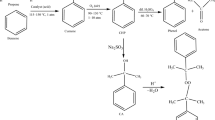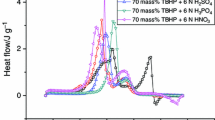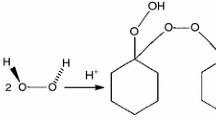Abstract
Organic peroxides (OPs) are very susceptible to thermal sources, chemical pollutants or even mechanical shock. Over the years, they have caused many serious explosions. Cumene hydroperoxide (CHP) is widely employed to produce phenol and dicumyl peroxide (DCPO) in the manufacturing process. Differential scanning calorimetry (DSC) and thermal activity monitor (TAM) were employed to determine the potential thermal hazards and thermokinetic parameters (such as exothermic onset temperature (T 0), maximum temperature (T max), and enthalpy (ΔH)) of CHP mixed with sodium hydroxide (NaOH) and sulfuric acid (H2SO4). High performance liquid chromatography (HPLC) was used to analyze the concentration vs. time of CHP.When CHP is mixed with NaOH, the T 0 is induced earlier and reactions become more intricate than the pure CHP solution. CHP added to NaOH or H2SO4 is more dangerous than pure CHP alone. Depending on the operating conditions, NaOH and H2SO4 are the incompatible chemicals for CHP.
Similar content being viewed by others
References
K. M. Luo, J. G. Chang, S. H. Lin, C. T. Chang, T. F. Yeh, K. H. Hu and C. S. Kao, J. Loss Prev. Process Ind., 14 (2001) 229.
United Nations, Committee of Experts on the Transport of Dangerous Goods, 14th Revised Ed., USA 2005, p. 205.
H. G. Fisher and D. D. Goetz, J. Loss Prev. Process Ind., 6 (1993) 183.
R. J. Schmidt, Appl. Catal., 89 (2005) 280.
NFPA 43B, National Fire Protection Association, 2007, Quincy, MA, USA.
Y. W. Wang, C. M. Shu, Y. S. Duh and C. S. Kao, Ind. Eng. Chem. Res., 40 (2001) 1125.
STARe Software with Solaris Operating System, Operating Instructions, Mettler Toledo, Switzerland 2004.
H. Y. Hou, T. S. Liao, Y. S. Duh and C. M. Shu, J. Therm. Anal. Cal., 83 (2006) 167.
H. Y. Hou, Y. S. Duh, W. H. Lin, K. H. Hu and C. M. Shu, J. Therm. Anal. Cal., 85 (2006) 145.
Y. W. Wang, Y. S. Duh and C. M. Shu, J. Therm. Anal. Cal., 85 (2006) 225.
H. Y. Hou, C. M. Shu and Y. S. Duh, AIChE J., 47 (2001) 1893.
J. R. Chen, S. H. Wu, S. Y. Lin, H. Y. Hou and C. M. Shu, J. Therm. Anal. Cal., 93 (2008) 127.
S. H. Wu, Y. W. Wang, T. C. Wu, W. N. Hu and C.M. Shu, J. Therm. Anal. Cal., 93 (2008) 189.
R. H. Chang, J. M. Tseng, J. M. Jehng, C. M. Shu and H. Y. Hou, J. Therm. Anal. Cal., 83 (2006) 57.
J. M. Tseng, R. H. Chang, J. J. Horng, M. K. Chang and C. M. Shu, J. Therm. Anal. Cal., 85 (2006) 189.
J. M. Tseng, Y. Y. Chang, T. S. Su and C. M. Shu, J. Hazard. Mater., 142 (2007) 765.
Author information
Authors and Affiliations
Corresponding author
Rights and permissions
About this article
Cite this article
Chen, Y.L., Chou, Y.P., Hou, H.Y. et al. Reaction hazard analysis for cumene hydroperoxide with sodium hydroxide or sulfuric acid. J Therm Anal Calorim 95, 535–539 (2009). https://doi.org/10.1007/s10973-008-9461-9
Published:
Issue Date:
DOI: https://doi.org/10.1007/s10973-008-9461-9




